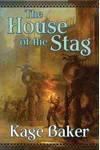Step into the whimsical and wildly imaginative world of Kage Baker’s Anvil of the World series, where clockwork caravans, half-demon playboys, and gourmet feasts collide in a fantasy romp like no other! This trilogy, blending humor, adventure, and sharp social commentary, follows a retired assassin navigating a vibrant world of feuding races and ancient prophecies. It’s a hidden gem for fantasy fans craving something fresh and delightfully quirky.
Baker, known for her time-travel sci-fi Company series, crafts a fantasy universe that’s both familiar and utterly unique, with a tone that dances between Terry Pratchett’s wit and Jack Vance’s flair. Let’s explore how this series came to be, its captivating stories, and why it continues to charm readers.
How Anvil of the World Began
Kage Baker, a versatile author with a knack for blending genres, debuted her fantasy career with The Anvil of the World in 2003. Drawing from stories she’d spun since childhood, Baker created a world where technology and magic coexist uneasily, inspired by classic fantasy tropes she playfully subverted. Her background in theater and love for sharp dialogue shaped the series’ lively, character-driven narrative, making it a departure from her sci-fi roots yet unmistakably hers.
Baker’s untimely death in 2010 left the series as a beloved but underappreciated part of her legacy. Published by Tor Books, the trilogy reflects her ability to weave humor and wisdom, earning praise for its inventive world-building and memorable cast.
The Heart of Anvil of the World
The trilogy kicks off with The Anvil of the World (2003), a collection of three novellas centered on Smith, a former assassin seeking a quiet life. Leading a caravan from Troon to Salesh, he’s joined by eccentric characters like Lord Ermenwyr, a decadent half-demon, and Mrs. Smith, a chef with a spicy past. The story spirals from caravan attacks to a hotel venture, culminating in a revelation about Smith’s destiny tied to a world-altering artifact.
The House of the Stag (2008), a prequel, dives into the origins of Lord Ermenwyr’s parents—a saintly Yendri and a demon lord—exploring themes of prejudice and reconciliation in a mythic narrative. The Bird of the River (2010) shifts to a river voyage, following orphaned siblings Eliss and Alder as they uncover secrets in a floating city, blending adventure with coming-of-age poignancy.
Set in a world of red-skinned, tech-savvy Children of the Sun, green-skinned, spiritual Yendri, and elemental demons, the series tackles identity, cultural clashes, and the weight of history. Baker’s witty prose and knack for turning tropes—like the “chosen one” or “evil artifact”—into surprising, heartfelt moments make each book a standalone yet interconnected delight.
Why Anvil of the World Resonates
The Anvil of the World series stands out for its blend of humor and heart, offering a refreshing take on fantasy that doesn’t take itself too seriously yet delivers profound insights. Fans on platforms like Goodreads praise its quirky characters and clever dialogue, often comparing it to Pratchett or Diana Wynne Jones. Though not a bestseller, its cult following cherishes its niche charm and Baker’s ability to make even demons relatable.
The series’ themes of tolerance and self-discovery remain relevant, resonating with readers who appreciate fantasy that mirrors real-world complexities. Its legacy lies in proving that lesser-known works can leave a lasting mark through creativity and authenticity.
- Publication Years: 2003, 2008, 2010
- Number of Books: 3
- Notable Recognition: The House of the Stag nominated for a 2009 World Fantasy Award
Dive into The Anvil of the World and let Kage Baker’s fantastical world sweep you away on a journey of laughs, surprises, and timeless wisdom!


